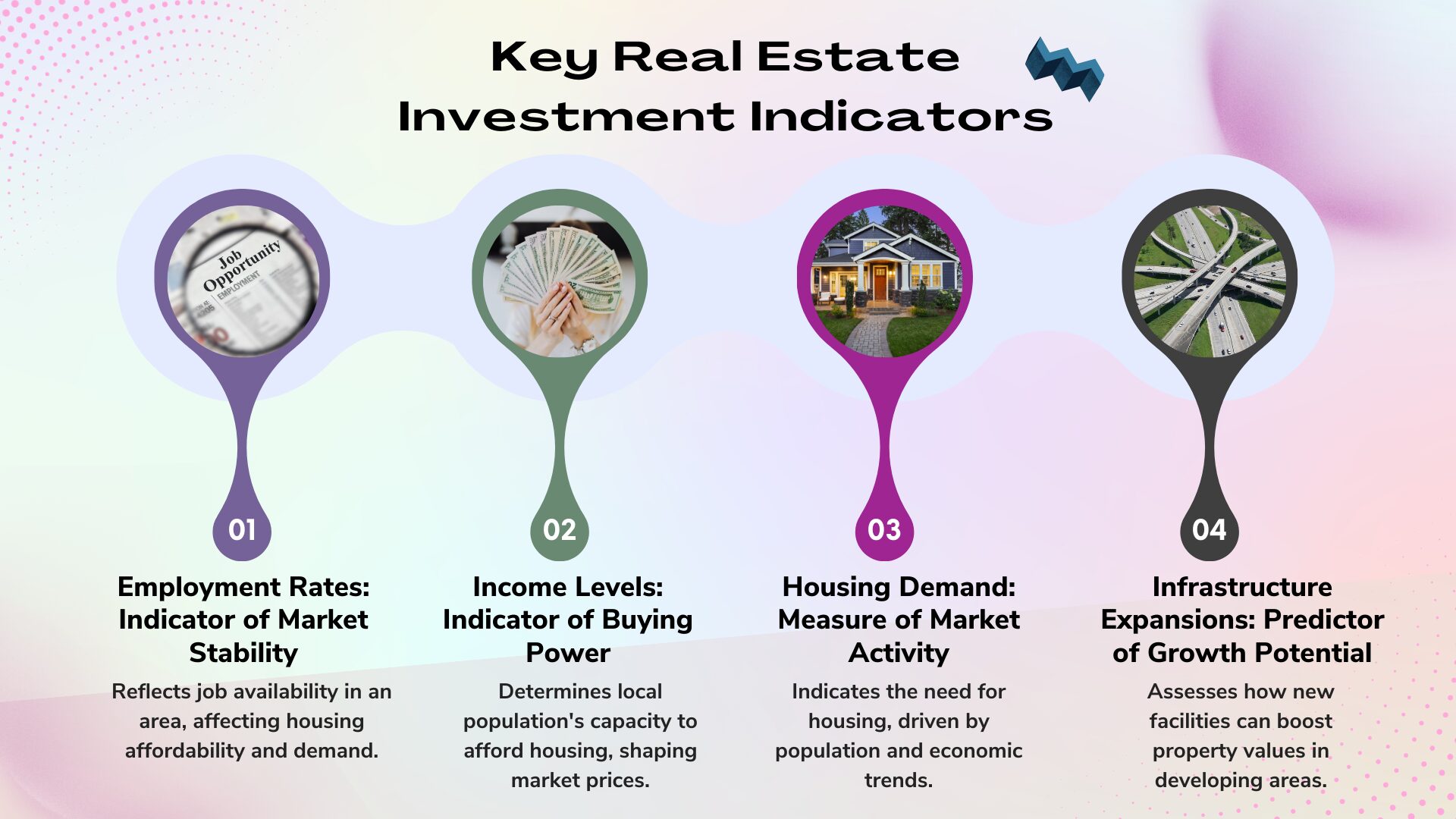Real estate investing can feel like navigating a maze at times. Finding the best markets ripe for raw land development takes insight into ever-changing conditions. Let’s break down how to pinpoint opportunities. However, with the right approach and information, an investor can find clarity even in complex situations. Though risk always exists in real estate, proactive research and observation aim to tilt the odds favorably. We’ll explore key data to analyze along with common pitfalls that trip up less prepared investors.
Where People Go, Development Follows
Migration patterns reveal promising markets. Areas attracting new residents tend to need more housing, businesses, and infrastructure – spurring development. It’s a self-perpetuating cycle. Logical, right? You want to invest where population and jobs are increasing, along with property values and economic growth.
The Science Behind Identifying the Hottest Markets
Identifying promising markets involves examining key data, not just taking a shot in the dark. A Google search showing top growth areas offers a start. But don’t fixate solely on percentages – high rates in tiny locales won’t move the needle. Compare percentages to total population numbers for useful intelligence.
While national data provides direction, local familiarity reveals hidden gems. Your backyard may offer unseen lucrative chances, even if not on top market lists. Intimate area knowledge gives you an edge. Drill down on relevant metrics: Employment rates, Income levels, Housing demand, Infrastructure expansions.

Scan for areas attracting new residents and businesses. Just remember markets heating up fast could soon peak. Take a balanced approach – combining verified data and community insights to uncover high potential zones while still ascending, before the secret gets out.
As we explore the dynamics of market selection, it’s essential to embrace the advancements in technology and the power of human connections. These elements not only supplement our understanding of market trends but also provide a competitive edge in pinpointing markets with high development potential.
Current Red Hot Markets
While positive demographic and economic trends indicate strong markets overall, some stand out:
Tennessee: Nashville is highlighted as a key market to watch, with strong development and investment prospects.
Arizona: Phoenix continues to be a standout market in Arizona, driven by positive metrics and strong growth.
Texas: Major metropolitan areas like Dallas, Houston, and Austin are expected to continue their robust expansion, making them attractive markets for real estate investment.
Georgia: Atlanta is another city in the Southeast with promising real estate opportunities.
These states and their respective cities are recognized for their strong growth potential, demographic trends, and investment opportunities. However, it’s important to note that real estate markets can be influenced by a variety of factors including economic conditions, interest rates, and local market dynamics, so continuous monitoring of these markets is advisable for informed decision-making.
Click here to learn more and subscribe to the newsletter
Technological Tools and Resources
In the realm of modern real estate investment, the importance of technological tools and resources cannot be overstated. These tools, ranging from sophisticated Geographic Information Systems (GIS) to advanced property development software, are revolutionizing the way investors approach market analysis and decision-making.
Geographic Information Systems (GIS)
GIS technology stands out as a game-changer. It enables investors to visualize complex demographic data on a map, simplifying the analysis of population trends, migration patterns, and urban development. This visualization helps in identifying regions experiencing significant growth or decline, allowing for more targeted investment strategies. Additionally, GIS can be used to analyze environmental factors, such as flood zones or proximity to key amenities, further refining the selection process.
Property Development Software
Property development software provides a granular analysis of the potential profitability of land parcels. It takes into account various factors such as local zoning laws, construction costs, and market demand to forecast potential returns. This software often includes project management features, helping investors track progress and manage budgets more effectively throughout the development process.
Online Databases and Analytical Platforms
Comprehensive online databases and analytical platforms have become indispensable. These resources compile vast amounts of data, including historical property values, rental market trends, and economic forecasts. Some platforms also offer predictive analytics, using algorithms to identify emerging markets before they become mainstream investment hotspots. This predictive capability is crucial for staying ahead in a competitive market.
Artificial Intelligence and Machine Learning
The integration of Artificial Intelligence (AI) and Machine Learning (ML) in real estate analysis is a frontier rapidly being explored. These technologies can process and analyze data at an unprecedented scale, identifying patterns and correlations that might be invisible to the human eye. AI-driven tools can provide predictive insights into market trends, price fluctuations, and investment risks, enabling more informed and strategic decision-making.
Mobile Applications
Mobile applications offer on-the-go access to crucial information and tools. From property listings to mortgage calculators, these apps allow investors to make quick, informed decisions from anywhere. Some apps also offer augmented reality features, enabling investors to visualize potential developments on a site or see a property’s history and projected value over time.
Crowdsourcing and Social Media Analysis
Finally, crowdsourcing platforms and social media analysis tools are emerging as valuable resources. They provide real-time market sentiment and investor discussions, offering a more grassroots perspective on market trends and potential investment opportunities.
Get your free “2024 Real Estate Market Outlook” now!
The Role of Networking and Relationships
While technology provides invaluable data, the human element in real estate investment is irreplaceable. Building a network of relationships within the real estate community can offer insights that no amount of data can replicate. Connections with local realtors, experienced developers, government officials, and fellow investors can provide insider knowledge and first-hand information about market dynamics and upcoming opportunities.
Engaging in real estate forums, attending industry conferences, and joining local investor groups are effective ways to build these relationships. These interactions can often lead to learning about off-market deals, understanding the nuances of local regulations, and identifying unique investment opportunities that are not yet on the mainstream radar. This blend of personal relationships and community insights plays a pivotal role in identifying and capitalizing on emerging markets for raw land development.
Conclusion
Identifying the hottest markets for raw land development requires a multifaceted approach. An investor must balance data-driven analysis with local knowledge and human insights. By leveraging technological tools for detailed market analysis and cultivating strong networks within the real estate community, investors can gain a comprehensive understanding of where and when to invest. Continual learning, adaptability to changing market conditions, and a blend of analytical and interpersonal skills are key to making informed and profitable investment decisions. In the complex and ever-changing landscape of real estate investment, striking the right balance between technology, data, and human insight is crucial for long-term success.
Key Points to Consider:
Effective Use of Technology: Harnessing the power of data analysis and digital tools to identify promising markets.
Local Market Understanding: Gaining insights from on-the-ground knowledge and community connections.
Dynamic Investment Strategy: Remaining adaptable to market shifts and continuously enhancing skills for informed decision-making.
Interested in multifamily real estate investing? Our experienced team is here to help. From market research to identifying the best opportunities, we guide you through the process. Subscribe to our YouTube channel for informative videos and expert discussions, and follow us on Instagram for exclusive content. Explore our comprehensive Udemy course for detailed insights and strategies. Ready to elevate your investment journey? Contact us now to schedule a consultation and achieve your financial goals in real estate.
*This content is for informational purposes only and is not intended as financial or legal advice. Please consult with a professional advisor before making any investment decisions.




























